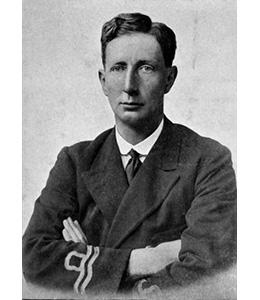Geoffrey Heneage Drummond was born on 25 January 1886 in Westminster, the fourth child of Algernon Heneage Drummond and his wife Margaret Elizabeth née Benson. Algernon Drummond had served in the Rifle Brigade in India and after his marriage worked in Drummonds Bank, but he is best known as the composer of the Eton Boating Song.
At the age of 9, Geoffrey fell down a flight of stone stairs and dislocated his neck, after which he suffered from severe headaches for the remainder of his life. Because of this, he found school difficult and only lasted for a few terms at Eton College before going to Clayesmore School then in Middlesex. Similarly, he only had a brief time at Christ Church, before changing to the Royal Agricultural College at Cirencester to study Estate Management.
He was a keen yachtsman, so volunteered for the Royal Naval Volunteer Reserve in 1915. After training he served in several Motor Launches in the English Channel and was appointed in command of ML254 in December 1917, based at Dover.
On 23 April 1918 (St George’s Day) there were raids on the German-occupied ports of Zeebrugge and Ostend which were intended to block the harbour entrances. The Zeebrugge Raid was successful, but the raid on Ostend was abandoned after the wind changed and blew away the smoke screen. A second attempt was made to block Ostend by sinking the cruiser HMS VINDICTIVE in the harbour entrance on the night of 9/10 May. ML254 rescued 38 men from the crew of HMS VINDICTIVE after they had scuttled their ship. Geoffrey Drummond together with Lt Rowland Bourke RNVR (Commanding Officer of ML276) and Lt Victor Crutchley RN (First Lieutenant of HMS VINDICTIVE) were awarded the Victoria Cross for their actions. He ended the war as a Lieutenant Commander RNVR and was also awarded the Legion d’Honneur by the President of France.
Due to injuries suffered on the Raid and his dislocated neck, he had difficulty finding work after the war but ended up working in the Headquarters of ICI.
At the outbreak of the Second World War, he tried hard to rejoin the RNVR, but was considered too old and unfit. Determined to serve, he signed up as a Second Hand (equivalent to an Able Seaman) in the River Emergency Service then transferred to the Royal Naval Patrol Service. In April 1941, while carrying a sack of coal, the leg, which had been injured during the Ostend Raid, gave way and he hit his head on the deck housing. He suffered a severe concussion and died on 21 April in St Olave’s Hospital, Rotherhithe. He was buried in Chalfont St Peter Cemetery, Buckinghamshire.
There have been numerous books written about the Zeebrugge and Ostend Raids, but two that are recommended are:
VCs of the First World War – The Naval VCs by Stephen Snelling, Sutton Publishing, Stroud Gloucestershire 2002
No Pyrrhic Victories: The 1918 Raids on Zeebrugge and Ostend by E C Coleman, The History Press, Stroud Gloucestershire 2014.

